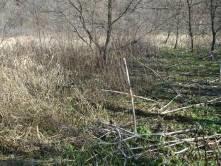Overview
We sought strategies to control reed canary grass and eventually return the area to a bottomland forest. Reed canary grass does not reproduce or survive in heavy shade. Techniques included thinning and pruning box elder followed by direct seeding operations in the absence of dense reed canary grass.
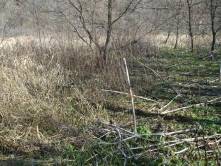
Figure 1: Reed canary grass on the left and suppressed by the box elder shade on the right, November 2006.
Silviculture Objective(s)
Objectives were to return the area to a bottomland hardwood forest community by controlling reed canary grass and box elder.
Pre-treatment stand description and condition
Stand establishment and management history:
Little management has occured in this area.
Pre-treatment species composition:
Thick stand of young box elder trees.
Pre-treatment forest health issues:
Presence and abundance of dense reed canary grass and box elder throughout the area. Box elder trees are native to Minnesota and are a pioneer species in old fields and former pastures, but have little wildlife or economic value. When growing in a dense stand, box elder will shade out most understory growth making the soil subject to erosion from flooding.
Landowner objectives/situation:
The ultimate goal is a healthy understory with open areas of sedges, reeds, and native forbs.
Silviculture Prescription
The thick stand of young box elder trees was thinned to no closer than four feet apart. Lower branches on the remaining box elder trees were removed to a height of seven feet to allow the area to be prepared by a small tractor and tiller. The site was tilled in mid September, 2007 and direct seeded to a mixture of the following species: bur oak, white oak, swamp white oak, black walnut, butternut, bitternut hickory, Kentucky coffee tree, Ohio buckeye, chokecherry, wild plum, dogwood, redbud, ninebark and false indigo seeds in late September and early October 2007.
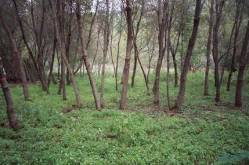
Figure 2: Box elders thinned and pruned. Most of the understory vegetation is shallow-rooted creeping Charlie, September 2007
What actually happened during the treatment
Fifteen bushels of walnuts per acre and five bushels of acorns per acre were seeded. Lesser amounts of the other species listed above were seeded based on the site and seed availability. The people doing the seeding carried buckets of seeds and spread them on the tilled soil. The larger seeds were worked in with the tiller running at a slow speed. The smaller seeds were sown on top of the ground.
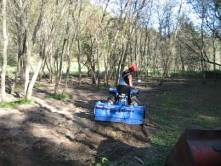
Figure 3: Burying the large seed, running the tiller slow and shallow, September 2007
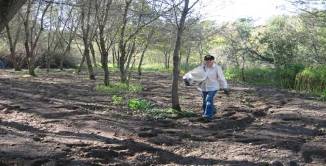
Figure 4: Seeding acorns after tilling. Walnuts already spread on the ground, September 2007.
Cut box elder trees were treated with Garlon herbicide to prevent resprouting. The trees were dropped and left on the seeded area. The removal of the canopy allowed sunshine to reach the new tree seedlings. We hope that the tangle of branches from the dropped trees will discourage deer from browsing the new trees. Willow, cottonwood, and tamarack seedlings were planted in 2008 and silver maple seed was sown on the area when those seeds were ripe, in June of 2008.
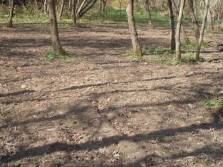
Figure 5: Research Area C07 after seeding, November 2007
The treatment where we planted under the box elders was only done once as only one acre of this habitat existed in our creek bottom. The plan with burning, spraying and direct seeding in open areas has been repeated annually for each of the last 10 years and due to seed availability and subsequent weather conditions, each planting has its own character and species mix.
Post-treatment assessment
We got a more dense stand of trees in the open treatment, but I liked using less chemicals in the box elder area and I see many available sites for this practice. With walnuts predominating the plantings, the shade is not dense enough to keep the reed canary grass from growing, but it is controlled long enough to establish the trees and it continues to be suppressed and we are getting a good growth rate on the trees.
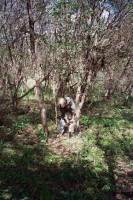
Figure 6: Thinning box elder trees and cutting low side branches to allow for later tillage, July 2007.
Other notes
If collecting your own seeds, prepare your seed storage early, as seed collection times can vary from year to year. We used a chest freezer modified with an override thermostat to convert it to a refrigerator and stored the collected seeds at 40 degrees F.
Oak, dogwood, chokecherry, wild plum, and other early maturing seeds may need to be collected up to six weeks before the later maturing seeds are ready. Since some of the larger seeds (including the walnuts) mature later and need to be planted first in a direct seeding, the earlier collected seeds will need proper storage. Scout out seed trees ahead of time. When the acorns and later walnuts begin to fall, you will be in a race with deer, squirrels, lawnmowers and desiccation to gather seeds. Seeds need to be kept moist and cool to maintain viability. Soak acorns in cold water prior to storing to chill and hydrate them. If using a freezer modified to work as a refrigerator, set thermostat at 60 degrees (or 10 degrees less than the temperature of the acorns if lower than 60 degrees) and lower it 10 degrees each day until you reach 40 degrees. This will allow the cold to spread from the walls of the freezer to the middle where the thermostat sensor is located without freezing the acorns next to the freezer walls. Look for the freezer/refrigerator override thermostat where wine and beer making supplies are sold.
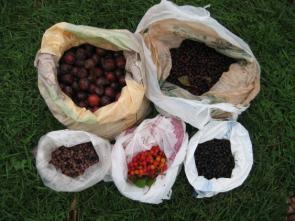
Figure 7: Seeds of shrubs.
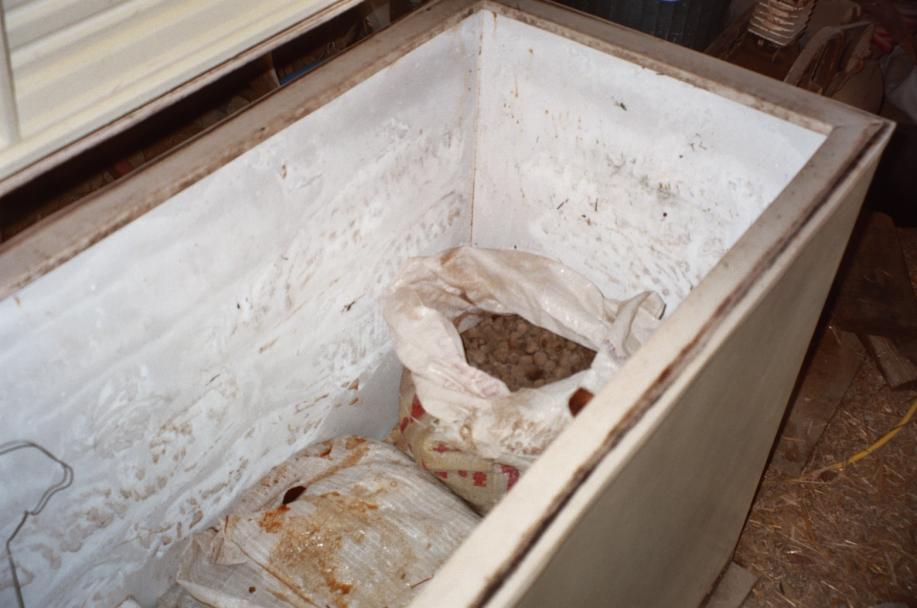
Figure 8: Bur oak acorns
We used a tool called a Nut Wizard to collect acorns, hickory nuts, butternuts and walnuts. The Nut Wizard saved considerable time and effort compared to picking by hand or raking and it is available in several sizes for various sized nuts. It works best on mowed areas, and we found a good supply of acorns and walnuts on lawns, golf courses and cemeteries. Most people are glad to give you their acorns and nuts if you pick them up.
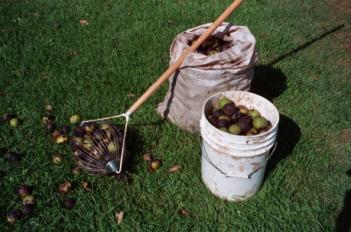
Figure 9: The Nut Wizard tool
Summary / lessons learned / additional thoughts
If your planting is near an existing forest, squirrels may view your direct seeding as an easy food source. To avoid the loss of planted seeds, provide an even easier food supply by making several piles of walnuts around the edge of the planting. Hopefully the squirrels will take these and leave your planted tree seeds in the ground.
We set out to grow trees, but between our Christmas trees, the bottomland trees and prairie plantings and having water access in the creek, we have created great deer habitat and that has taken a toll on the diversity we had hoped for in our direct seeding. When walnut is planted in high density enough can make it above deer browse to create a good stand. The oaks have tended to disappear under the deer pressure. Just this year we have tried a broadcast spray of Plantskydd and the oaks seem to be holding their own. If this continues to work, I would plant more acorns and less walnuts and treat with Plantskydd for 4 or 5 years until the oak can make it on their own.
We have also had some success with planting cottonwood and willow poles. In a year with average rainfall nearly 100% of the willow will survive but only about 25% of the cottonwood. The cottonwood poles that survive quickly grow into nice trees, but I have not been able to determine what to do differently to increase my success rate with the cottonwood poles. We also have trouble with beaver moving in and harvesting the cottonwood and willow we have planted. We have started painting the poles with a mixture of latex house paint mixed with sand and have not lost a treated tree to beaver harvest in spite of having beavers in the area. It is exciting to me to see these trees growing in solid Reed Canary Grass in areas that are not accessible to do a direct seeding.
This case study was developed with support from the United States Department of Agriculture's National Institute for Food and Agriculture (USDA-NIFA), Renewable Resources Extension Act (RREA). Project #MIN-44-E02, principal investigator Eli Sagor, University of Minnesota.
